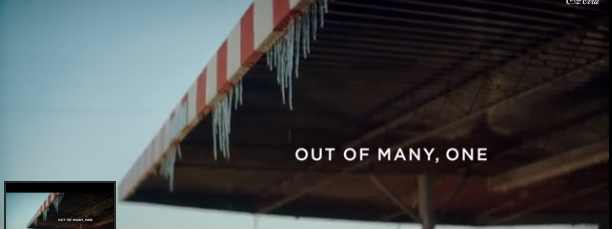Earlier this month, as the Super Bowl went underway, one ad sparked more controversy than any other: Coca-Cola’s. Despite lasting only sixty seconds, a national conversation on the issue of multilingualism and diversity ensued. Disputes broke out on social media. Both conservative and liberal politicians and commentators argued over whether the ad was anti-American or pro-American. Against the will of detractors, Coca-Cola defiantly aired the ad again during the opening of the Sochi Winter Olympics, this time televising the ninety-second version and adding the phrase “E Pluribus Unum” (Latin for “out of many, one”) to the beginning.
So what was it that caused so much controversy? Singing “America the Beautiful” in other languages.
Nine languages were represented in the song: English, Spanish, Tagalog, Mandarin, Hindi, Hebrew, Keres, French, and Arabic. All of these languages—with the sole exception of Keres, which is a language native to the Pueblo Indian peoples of New Mexico—were brought to the land we currently call the United States, English included. Really, unless you are one of the small percentage of Americans who claim Native American heritage, at some point your ancestors (or maybe even you or one or more of your parents) immigrated here by foot, boat, or plane.
Diversity has been a particularly important issue recently. The idea of “being American” is so widely debated and open to interpretation that no one can truly pinpoint what it means. How much of your “foreign” culture can you retain—whether it’s Irish, Indonesian, or Iranian—and still consider yourself a part of American culture? Does it mean anything if America’s most common last names range from Smith, Johnson, and Williams to Garcia, Rodriguez, and Martinez?
There is no denying that the face of America is changing. According to a Pew Research poll, the state of New Mexico has more Hispanics than any other ethnic/racial group. The amount of Hispanics will exceed the amount of white people in the state of California as early as next month, and Texas is next to follow. In Hawaii, Asian Americans and Pacific Islanders are the largest ethnic groups, making up nearly half the population of the state.
But with the growing amount of diversity in America, xenophobia, the intense or irrational dislike or fear of people from other countries, has increased. Following the attacks on September 11, multiple acts of violence were committed against Americans of Middle Eastern descent and South Asian descent, particularly those who practiced Islam and Sikhism, despite having no connections to the tragic terrorist attacks. With the rise of social media, images potentially causing xenophobia and racism have been more easily broadcasted to the world, like in the cases of the crowning of an Indian-American “Miss America,” the Cheerios ads that featured a white mom, black dad, and mixed race child, and even more recently, a multilingual Coca-Cola ad.
Despite many Americans speaking a language other than English at home, airing an ad featuring some of these languages is considered controversial. Even though all nine of the girls singing for the Coca-Cola ad were Americans, critics viewed it as “politically divisive” and anti-American.
However, the pinnacle of America is diversity! As I would always hear people say when I was younger, America is a melting pot. In reality, America is much more of a fruit salad than it is a melting pot. People from all walks of life, from all six major continents, come to this country, bringing distinct aspects of their cultures with them. These diverse traditions mix with other cultural customs already here, forming something radically different yet similar—much like how the tastes of individual fruits in a fruit bowl mix together yet don’t stop the fruit being what it was before.
This is just like the United States. This country is composed of many diverse groups of people. And out of these many people who come from different countries and different cultures, we create one America. It’s not about erasing culture; rather, it’s about letting the many distinct cultures of this country coexist. When you make a beautiful fruit bowl, you don’t tell the watermelons to be just like strawberries. It’s the same with America; when you make a beautiful America, you don’t tell new immigrants to become “just like everyone else.” The true beauty of this country is that we embrace people from all walks of life, all people who make up what we know as the United States of America.
The whole notion that the Coca-Cola ad was anti-American is just mind-boggling. How can anyone say that the use of languages other than English is “anti-American”? This country has no official language, even though English is the most widely spoken. And just the fact that we don’t have to have an official language is a testament to how so many different people can be united as one country without having to force English to “unite us.” And it’s not like all nine languages were used to talk about England, Latin America, the Philippines, China, India, Israel, Pueblo towns, France, or Arab countries. No, all nine languages were used to express the beauty of this country to make the point that no matter what languages we speak, what countries we emigrated from, and what races we are, America is beautiful.
It’s often too easy to think of Americans only as people with fair skin, blue eyes, and blonde hair when that’s simply not the case. In a very short and succinct way, this is the very beauty of the Coca-Cola ad—that it shows the different facets of what it means to live in this country, what it means to be an American. To be American doesn’t include the giving up of a culture in exchange for a new one. It doesn’t include the giving up of one language for another. Rather, being an American is not something any one group of people can define. And part of the beauty of the concept of being American are the varied responses from all the varied people in this country. To me, being an American is simply embracing what I consider most beautiful about the United States—the freedoms to speak any language you want, to be a part of any religion you want, and to practice any culture you want.
It’s the beginning of the year 2014. The United States has gone a very long way since its genesis, and we must make sure it continues moving forward. It’s time for every American to realize that America will always be America, regardless of which race is the majority or whether multilingualism becomes the new thing.
It’s the beginning of the year 2014. It’s absolutely time to start seeing more ads like Coca-Cola’s, more ads that positively represent the diversity we have and enjoy in this country. Even small, sixty or ninety-second clips can act as a great stepping stone to realizing the varying types of people, languages, cultures, and lifestyles we have the freedom to practice.
It’s the beginning of the year 2014. We have to create an environment where more companies can include the realities of American diversity in their advertisements without fear of boycotts and backlash. As more diverse people and cultures are showcased in the media, Americans’ paradigms will slowly shift so that eventually all people can recognize the myriad of cultures in this country and that we truly are a big, beautiful fruit bowl.
It’s the beginning of the year 2014. All of us who consider ourselves American must stand united together and show people who feel pushed away because of the cultures they hold so dear that they don’t have to give them up. We have to send a strong message that we are only where we are and we can only continue moving forward if we allow our many separate cultures to coexist and make the beautiful diverse America we have today.
It’s the beginning of the year 2014. But even though we’re so far in the future, we must continue to look back on one important phrase showcased on the Great Seal of the United States: E pluribus unum. Out of many, one.






